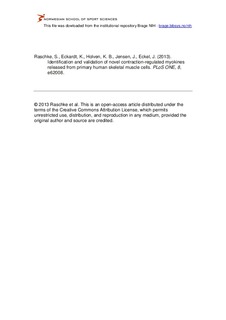| dc.contributor.author | Raschke, Silja | |
| dc.contributor.author | Eckardt, Kristin | |
| dc.contributor.author | Holven, Kirsten Bjørklund | |
| dc.contributor.author | Jensen, Jørgen | |
| dc.contributor.author | Eckel, Jürgen | |
| dc.date.accessioned | 2013-05-23T11:26:35Z | |
| dc.date.available | 2013-05-23T11:26:35Z | |
| dc.date.issued | 2013-04-24 | |
| dc.identifier | Seksjon for fysisk prestasjonsevne / Department of Physical Performance | |
| dc.identifier.citation | PLoS ONE. 2013, 8(4), e62008 | no_NO |
| dc.identifier.uri | http://hdl.handle.net/11250/171110 | |
| dc.description | © 2013 Raschke et al. This is an open-access article distributed under the terms of the Creative Commons Attribution License, which permits
unrestricted use, distribution, and reproduction in any medium, provided the original author and source are credited. | no_NO |
| dc.description.abstract | Proteins secreted by skeletal muscle, so called myokines, have been shown to affect muscle physiology and additionally
exert systemic effects on other tissues and organs. Although recent profiling studies have identified numerous myokines,
the amount of overlap from these studies indicates that the secretome of skeletal muscle is still incompletely characterized.
One limitation of the models used is the lack of contraction, a central characteristic of muscle cells. Here we aimed to
characterize the secretome of primary human myotubes by cytokine antibody arrays and to identify myokines regulated by
contraction, which was induced by electrical pulse stimulation (EPS). In this study, we validated the regulation and release of
two selected myokines, namely pigment epithelium derived factor (PEDF) and dipeptidyl peptidase 4 (DPP4), which were
recently described as adipokines. This study reveals that both factors, DPP4 and PEDF, are secreted by primary human
myotubes. PEDF is a contraction-regulated myokine, although PEDF serum levels from healthy young men decrease after
60 min cycling at VO2max of 70%. Most interestingly, we identified 52 novel myokines which have not been described
before to be secreted by skeletal muscle cells. For 48 myokines we show that their release is regulated by contractile
activity. This profiling study of the human skeletal muscle secretome expands the number of myokines, identifies novel
contraction-regulated myokines and underlines the overlap between proteins which are adipokines as well as myokines. | no_NO |
| dc.language.iso | eng | no_NO |
| dc.publisher | PLOS One | no_NO |
| dc.subject | adipokines / secretion | |
| dc.subject | adolescent | |
| dc.subject | adult | |
| dc.subject | dipeptidyl peptidase 4 / blood, secretion | |
| dc.subject | eye proteins / blood, secretion | |
| dc.subject | middle aged | |
| dc.subject | muscle cells / secretion | |
| dc.subject | muscle contraction / physiology | |
| dc.subject | muscle proteins / blood, secretion | |
| dc.subject | muscle, skeletal / metabolism | |
| dc.subject | nerve growth factors / blood, secretion | |
| dc.subject | protein array analysis | |
| dc.subject | serpins / blood, secretion | |
| dc.subject | young adult | |
| dc.title | Identification and validation of novel contraction-regulated myokines released from primary human skeletal muscle cells | no_NO |
| dc.type | Journal article | no_NO |
| dc.type | Peer reviewed | no_NO |
| dc.subject.nsi | VDP::Mathematics and natural science: 400::Basic biosciences: 470 | no_NO |
| dc.subject.nsi | VDP::Agriculture and fishery disciplines: 900::Agriculture disciplines: 910 | no_NO |
| dc.identifier.doi | 10.1371/journal.pone.0062008 | |
